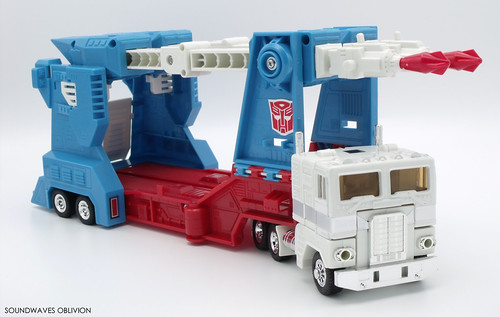(Character Card Translation)
C-69 Cybertron City Commander Ultra Magnus
Function: City Commander
Transformation: Carrier Trailer
Ability: A well balanced warrior, combining combat ability, courage, and adaptability on the battlefield.
Character: Resolute, fair and courageous; an exemplary City Commander. When under Convoy’s instruction, he shows his true potential.
Weapon(s): Super Blaster Gun; Missile Launchers
STR…9; INT...9; SPD...6; END...8; RNK...8; CRG...9; FPR...6; SKL...8
Also See:
"Ultra Magnus" made his debut in August 1984 in Takara's renowned Diaclone Car Robot series, under the moniker
"Powered Convoy." This early rendition of Ultra Magnus stood in stark contrast
to its eventual Hasbro Transformers counterpart, sporting distinctive colours
and an extra robot figure known as "Powered Buggy."
Powered Convoy was a car carrier, characterised by a striking blue cab and an
accompanying trailer adorned in a palette of grey, red, and blue.
Intriguingly, a Japanese trailer for the iconic 1986 Transformers movie briefly showcased Ultra Magnus in the original Diaclone colour scheme. However, this glimpse does not necessarily imply that these were the intended colours for Ultra Magnus. The production of the Transformers movie began in mid-1984, providing animators with access to early toy prototypes and concepts, which might explain this temporary alignment with the Diaclone aesthetics.
Drawing parallels to the marketing tactics employed for other Transformers characters, such as Jetfire and Soundwave, Ultra Magnus was initially promoted as the new Autobot Leader in various European toy catalogues. While technically accurate during the course of the animated movie's narrative, this promotional angle added to the excitement surrounding Ultra Magnus's introduction.
The official release of Ultra Magnus was in 1986, unveiling a packaging that hinted at the character's initial colour scheme. On these packaging materials and promotional photos, Ultra Magnus showcased a distinctive white chest plate, deviating from the blue chest plate found within the box.
The initial release of Ultra Magnus boasted a slew of premium features, including rubber tires, painted robot faces, die-cast metal feet for the smaller robot component, and chrome-finished legs and cab windows. However, in a later running change for a cost-saving measure, several alterations were made. The rubber tires were replaced with more cost-effective plastic counterparts, the robot's feet transitioned to plastic, and certain paint applications were omitted.
Delving into the intricacies of Ultra Magnus's design, it's noteworthy that, compared to its Diaclone predecessor, the Transformers release omitted the "Powered Buggy" accessory. However this was not to be forgotten with Takara Tomy retroactively including Powered Buggy into the Transformer series, renaming it "Power Drive" and adding it to the MP-31 Delta Magnus story. Additionally, the chest plate underwent modifications; its wheels were removed, aligning with the shift away from being a Diaclone pilot's vehicle and explaining the presence of a seat within the chest plate.
In its vehicle mode, Ultra Magnus assumed the role of a formidable car carrier, offering space for two Autobot cars atop its frame and an additional two on its flatbed section. The design allowed the white ramps to descend, facilitating the graceful disembarkation of the cars. Moreover, the top section ingeniously rotated downward to enable cars to be loaded from the upper level. Interestingly, the box art even portrayed Ultra Magnus as an aircraft launcher, a feature originally intended for the Diaclone jets in the Diaclone series.
The compact white cab bore a striking resemblance to Optimus Prime's, with distinctions in colour and weaponry. Although the small robot form seldom graced the original Transformers cartoon, Ultra Magnus primarily commanded attention in its imposing larger robot configuration. Significantly, the trailer exhibited the versatility to transform into a fully functional base and repair bay, paralleling Optimus Prime's iconic trailer. However, Ultra Magnus's trailer possessed the added capability to merge with the small robot, thereby forming the towering, imposing larger robot persona.
In this larger robot mode, Ultra Magnus exhibited a degree of articulation, with the arms being particularly well-posed for its era. The robot mode also retained the use of the same gun, albeit requiring it to be inverted to seamlessly fit into the larger fists, adding a layer of versatility to its arsenal.
Takara's celebration of the Transformers 15th Anniversary culminated in the reissuing of Ultra Magnus as one of the three initial figures, alongside Convoy and Hot Rodimus. These reissues were masterfully executed, closely mirroring the original packaging design, albeit without the Styrofoam inserts. Notably, a gold sticker prominently graced the box, designating it as the "Transformers 15th Anniversary Reissue Edition," accompanied by a character card.
Subsequently, albeit two years later, Hasbro joined, offering its own versions
of these reissues. However, due to stringent safety standards, Ultra Magnus
underwent a distinctive alteration—its smokestacks were noticeably shortened,
and the missiles grew to comically exaggerated lengths.
As the years have rolled on, Ultra Magnus has undergone numerous re-imaginings and reiterations, solidifying its place as a beloved Transformers character. Among these, the standout is the updated 2014 Masterpiece version, MP-22 Ultra Magnus, which brought a heightened level of detail and accuracy to collectors. Additionally, the Studio Series 86 Ultra Magnus would draw inspiration from the MP-22 masterpiece rendition.
In summary, Ultra Magnus's journey from its origins in the Diaclone Car Robot series to its enduring legacy in the Transformers universe is a testament to the character's timeless appeal and the ongoing evolution of the Transformers toy line.

















No comments:
Post a Comment